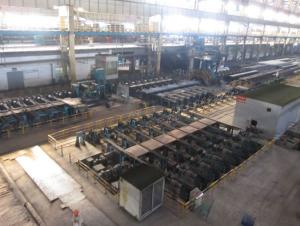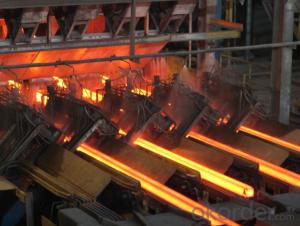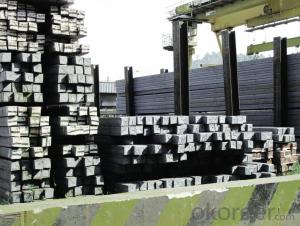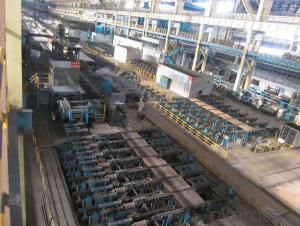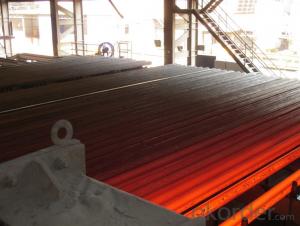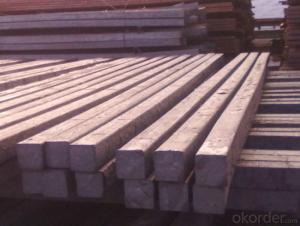Hot Rolled Square Steel Billet 3SP Standard 90mm
- Loading Port:
- Shanghai
- Payment Terms:
- TT OR LC
- Min Order Qty:
- 2000 m.t.
- Supply Capability:
- 10000 m.t./month
OKorder Service Pledge
OKorder Financial Service
You Might Also Like
Structure of Hot Rolled Square Steel Billet 3SP Standard 90mm

Description of Hot Rolled Square Steel Billet 3SP Standard 85mm
PPGI is made by cold rolled steel sheet and galvanized steel sheets as baseplate, through the surface pretreatment (degreasing, cleaning, chemical conversion processing), coated by the method of continuous coatings (roller coating method),
and after roasting and cooling. Zinc coating: Z60, Z80, Z100, Z120, Z180, Z275, G30, G60, G90
Alu-zinc coating: AZ60, AZ80, AZ100, AZ120, AZ180, G30, G60, G90

Main Feature of Hot Rolled Square Steel Billet 3SP Standard 90mm
1) Excellent corrosion resistance: The zinc layer provides a good protection of Pre-painted Galvanizeed Steel Sheet.
2) High heat resistance: The reflective surface of the material aids in efficiently reflecting the sunlight away and in turn reducing the amount of heat transmitted. The thermal reflectivity converts into energy savings.
3) Aesthetics: Pre-Painted Galvanized steel sheet is available in plethora of patterns and multiple sizes as per the requirements that given by our customers.
4) Versatility: can be used in the various areas.Standard seaworthy export packing: 3 layers of packing, inside is kraft paper, water plastic film is in the middle and outside GI steel sheet to be covered by steel strips with lock, with inner coil sleeve.
Applications of Hot Rolled Square Steel Billet 3SP Standard 90mm
1) Automotive bodies: filters, fuel tanks, etc.
2) Construction materials: roofings, welding pipes,
3) Electric and electronic appliances: computer cans, etc.
4) Steel cans: containers, etc.
5) Steel furniture: washing machines, refrigerators, microwaves, etc.
6) Drums
7) Office equipment: printer, recorders, etc.
8) Motors and transformers

Specifications of Hot Rolled Square Steel Billet 3SP Standard 90mm
| Classified symbol | Yield Point Minimum N/mm2 | Tensile Strength Minimum | Elongation Minimum % | Application | ||||
| N/mm2 | Nominal Thickness mm (t) | |||||||
| JIS | Yogic | 0.25-0.4 | 0.4-0.6 | 0.6-1.0 | 1.0-1.6 | |||
| G3312 | specification | |||||||
| CGCC | CGCC | -205 | -270 | -20 | -21 | -24 | -24 | Commercial |
| CGCD | CGCD | --- | 270 | --- | 27 | 31 | 32 | Drawing |
| --- | CG340 | 245 | 340 | 20 | 20 | 20 | 20 | Structural |
| CGC400 | CG400 | 295 | 400 | 16 | 17 | 18 | 18 | Structural |
| CGC440 | CG440 | 335 | 440 | 14 | 15 | 16 | 18 | Structural |
| CGC490 | CG490 | 365 | 490 | 12 | 13 | 14 | 16 | Structural |
| CGC570 | CG570 | 560 | 570 | --- | --- | --- | --- | Structural |
| ASTM Designation | Yield Point Minimum | Tensile Strength Minimum | Elongation Minimum % | Application | Q/BQB 445-2004(China standard) | ASM A653/A653M | JISG 3312 | |
| ksi(MPa) | ksi(MPa) | TDC51D+Z | (CS TYPE A+Z) | CGCC | ||||
| A653(M)-99 CS TYPE A,B,C | --- | --- | --- | Commercial | TDC52D+Z | CGCD | ||
| A653(M)-99 FS | --- | --- | --- | Lock Forming | TS250GD+Z | (G250+Z) | - | |
| A653(M)-99 DS | --- | --- | --- | Drawing | TS300GS+Z | (G300+Z) | CGC 400 | |
| A653(M)-99 SS Grade33(230) | 33(230) | 45(310) | 20 | Structural | TS350GD+Z | (G350+Z) | CGC490 | |
| A653(M)-99 SS Grade37(255) | 37(255) | 52(360) | 18 | Structural | TS550GD+Z | (G550+Z) | CGC570 | |
| A653(M)-99 SS Grade40(275) | 40(275) | 55(380) | 16 | Structural | ||||
| A653(M)-99 SS Grade50(345) | 50(345) | 65(450) | 12 | Structural | ||||
| A653(M)-99 SS Grade80(550) | 80(550) | 82(570) | --- | Structural | ||||
FAQ of Hot Rolled Square Steel Billet 3SP Standard 90mm
We have organized several common questions for our clients,may help you sincerely:
1. How Can I Visit There?
Our company is located in Tianjin City, China, near Beijing. You can fly to Tianjin Airport Directly. All our clients, from home or aboard, are warmly welcome to visit us!
2. How Can I Get Some Sample?
We are honored to offer you sample.
3. Why choose CNBM?
1, ISO, BV, CE, SGS approved.
2, Competitive price and quality.
3, Efficient service team online for 24 hours.
4, Smooth production ability(50000tons/month) .
5, quick delivery and standard exporting package.
6, Flexible payment with T/T, L/C, Paypal, Kunlun bank, etc .
- Q:How are steel billets used in the manufacturing of tooling?
- Tooling manufacturing relies heavily on steel billets as a vital element. Tooling involves the creation and design of tools utilized across different industries for the purpose of cutting, shaping, or forming materials. Steel billets are semi-finished goods formed by casting molten steel and subsequently hot rolling them into diverse sizes and shapes. In tooling manufacturing, steel billets serve as the fundamental material from which tools are shaped. Typically, these billets are crafted from high-quality steel alloys known for their exceptional strength, durability, and resistance to wear. The presence of these traits is crucial in tooling applications as they guarantee the longevity and performance of the tools. Once steel billets are acquired, they undergo a series of processes to transform them into tooling components. The initial step entails heating the billets to a specific temperature, often exceeding the recrystallization temperature. This elevation in temperature renders the steel more malleable and easier to shape. This process is referred to as hot working. Subsequent to heating, the steel billets are shaped into the desired form using a variety of techniques including forging, extrusion, or rolling. These methods enable the steel to be molded into intricate shapes such as dies or molds, which are commonly employed in tooling applications. The shaping process ensures that the tooling components possess the requisite dimensions, surface finish, and structural integrity to effectively fulfill their intended purpose. Once the tooling components are shaped, they may undergo additional heat treatments to further enhance their mechanical properties. Processes such as tempering, annealing, or hardening are frequently employed to modify the steel's hardness, toughness, and resistance to wear. These treatments augment the lifespan of the tooling and enhance its performance in demanding manufacturing environments. In summary, steel billets play a vital role in tooling manufacturing by serving as the initial material for shaping tooling components. The utilization of high-quality steel in billets provides the necessary strength and durability required for tooling applications. Through the process of shaping, heat treating, and finishing these billets, manufacturers are able to create tooling that meets the specific requirements of diverse industries, enabling efficient and precise cutting, shaping, and forming of materials.
- Q:What are the different types of steel billet forming processes?
- The different types of steel billet forming processes include hot rolling, cold rolling, extrusion, forging, and casting.
- Q:The form of carbon in carbon steels
- The solubility of carbon content when the iron carbon alloy than in the iron when the excess carbon can be in the form of carbide iron or elemental state (graphite) in alloy, which can form a series of carbide, Fe3C (cementite, 6.69%C) is a metastable phase, it is a compound complex structure gap. Graphite is a stable phase of iron carbon alloy with simple six - party structure. Fe3C has the potential to break down into iron and graphite stable phases, but the process is extremely slow at room temperature.
- Q:Can steel billets be used in the production of automotive components?
- Yes, steel billets can be used in the production of automotive components. Steel billets are semi-finished steel products that are typically used to produce various types of steel products, including automotive components. They can be further processed through rolling, forging, or other manipulation techniques to form the desired shape and size of the automotive component. Steel is a preferred material for automotive components due to its high strength, durability, and ability to withstand harsh operating conditions. Moreover, the use of steel billets allows for flexibility in manufacturing, as they can be tailored to meet specific design requirements and performance specifications of different automotive components.
- Q:How do steel billets contribute to energy efficiency?
- Steel billets contribute to energy efficiency in several ways. Firstly, the production of steel billets typically involves recycling scrap metal, which requires significantly less energy compared to producing steel from raw materials. This recycling process helps conserve energy and reduces the carbon footprint associated with steel production. Additionally, steel billets are often used as a raw material in various industries, such as construction and manufacturing. The durability and strength of steel make it a long-lasting and energy-efficient material for building structures and producing goods. Its high thermal conductivity also allows for efficient heat transfer, making it suitable for applications that require temperature control or energy conservation. Overall, steel billets play a vital role in promoting energy efficiency by minimizing energy consumption during production and offering sustainable solutions in various sectors.
- Q:What is the role of steel billets in the automotive industry?
- In the automotive industry, steel billets play a crucial role in the production of various components and parts for vehicles. Steel billets are essentially semi-finished steel products that undergo further processing to be transformed into the desired shape and size required for automotive applications. One of the primary uses of steel billets in the automotive industry is for the production of engine and transmission components. These include crankshafts, connecting rods, camshafts, gears, and other parts that require high strength and durability. Steel billets are used as raw material for forging or casting these components, ensuring they can withstand the rigorous demands of engine operation. Another significant application of steel billets in the automotive sector is for the production of structural components. These components, such as chassis frames, suspension parts, and body panels, require high strength and stiffness to provide safety and rigidity to the vehicle. Steel billets are processed through various techniques like hot rolling, cold rolling, or extrusion to produce the necessary forms and shapes needed for these structural components. Moreover, steel billets are also utilized in the manufacturing of fasteners like bolts, nuts, and screws, which are essential for assembling different parts of the vehicle. These fasteners need to possess excellent tensile strength and resistance to vibration and corrosion, making steel billets an ideal choice for their production. Additionally, steel billets find application in the production of various other automotive components, such as axles, wheel hubs, brake discs, and steering system parts. All these components require the superior mechanical properties offered by steel billets, including high strength, toughness, and resistance to wear and tear. In summary, steel billets play a vital role in the automotive industry by serving as the raw material for the production of engine and transmission components, structural components, fasteners, and other crucial parts. Their exceptional mechanical properties make them an ideal choice for applications that demand high strength, durability, and reliability, ensuring the safety and performance of vehicles on the road.
- Q:How are steel billets used in the manufacturing of industrial tools?
- Steel billets are an essential raw material in the manufacturing of industrial tools. These billets, which are solid blocks of steel, serve as the foundation for creating various types of tools used in industries such as construction, automotive, and manufacturing. The first step in using steel billets for tool manufacturing is to heat them to a specific temperature. This process, known as forging, makes the steel more malleable and easier to work with. Once heated, the billets are then shaped and formed into the desired tool design using specialized machinery like power hammers and presses. The shaping process involves applying intense pressure to the heated billet, which transforms it into the desired tool shape. This can be a chisel, wrench, hammer head, or any other tool needed for specific industrial applications. The precise shaping ensures that the tool will have the necessary strength, durability, and functionality required for its intended use. After the initial shaping is complete, the tool is further refined and finished through processes like machining, grinding, and heat treatment. These additional steps help enhance the tool's performance and ensure its longevity. Machining removes any excess material and creates the necessary holes, threads, or other features required for the tool's functionality. Grinding provides a smooth surface finish and precise dimensions. Heat treatment is another critical process that involves subjecting the tool to controlled heating and cooling cycles. This treatment alters the steel's molecular structure, enhancing its hardness, strength, and toughness. Different heat treatment techniques like quenching and tempering are employed depending on the specific tool requirements. Once the tool has been shaped, machined, ground, and heat-treated, it undergoes a series of quality checks and inspections to ensure it meets the necessary specifications and standards. These checks include dimensional measurements, visual inspections, and functional tests to ensure that the tool is fit for its intended purpose. In summary, steel billets are integral to the manufacturing of industrial tools as they provide the base material that is shaped, machined, heat-treated, and refined to create durable and high-performing tools. The versatility and strength of steel make it an ideal choice for producing a wide range of tools used in various industries, contributing to their efficiency, productivity, and overall success.
- Q:How are steel billets used in the manufacturing of food processing machinery?
- Food processing machinery relies on steel billets for the production of various components and structures. These billets undergo heating and rolling processes to form steel bars, rods, or sheets of different shapes and sizes. These steel products are then utilized in the construction of the framework, body, and other parts of the machinery. Steel's high strength and durability make it an ideal choice for food processing machinery, which often operates in harsh conditions and requires resistance to corrosion, wear, and high temperatures. Steel billets are carefully selected for their quality and suitability for the intended application. When constructing food processing machinery, steel billets are employed in fabricating crucial components like cutting blades, mixing paddles, conveyor belts, and grinding plates. These components are vital for the efficient processing and handling of food products, ensuring consistent quality and safety. Furthermore, steel billets are also used in manufacturing structural supports, frames, and housing for machinery. These structures provide the necessary stability, rigidity, and support to ensure the proper functioning and longevity of the food processing equipment. In conclusion, steel billets play a vital role in the manufacturing of food processing machinery as they provide the essential raw material required to create durable, reliable, and efficient equipment. The quality and characteristics of steel contribute to the performance, safety, and hygiene standards demanded in the food processing industry.
- Q:What are the factors that determine the lifespan of steel billets?
- The lifespan of steel billets is influenced by several factors. Firstly, the quality of the steel used in the production of billets is critical. Steel with high levels of impurities or inconsistent composition may have a shorter lifespan. The manufacturing process also plays a significant role. If the steel billets are not properly heated, cooled, or rolled, they may develop internal stresses or defects that can lead to premature failure. Environmental factors also impact the lifespan of steel billets. Exposure to corrosive substances, such as chemicals or moisture, can result in corrosion and degradation of the steel. Additionally, extreme temperatures can cause thermal expansion and contraction, leading to fatigue or cracking of the billets over time. The handling and storage of steel billets are also important factors. If they are mishandled, dropped, or subjected to excessive impact, it can lead to deformation or microstructural changes that reduce their lifespan. Proper storage conditions, including protection from moisture, direct sunlight, and extreme temperature fluctuations, can help preserve the integrity of the billets. Regular maintenance and inspection also contribute to determining the lifespan of steel billets. Timely detection and repair of any defects or damages can prevent further deterioration and extend their lifespan. In summary, the quality of the steel, manufacturing process, environmental conditions, handling and storage practices, as well as maintenance and inspections, all play crucial roles in determining the lifespan of steel billets.
- Q:How can the quality of steel billets be improved?
- The quality of steel billets can be improved through various methods such as enhancing the raw material selection, refining the manufacturing process, implementing stringent quality control measures, and adopting advanced technologies. These measures can include using high-quality iron ore and scrap metal as raw materials, employing advanced refining techniques like vacuum degassing and ladle furnace treatment, optimizing the casting and rolling processes, and implementing non-destructive testing methods to detect any defects. Additionally, continuous monitoring of the production parameters and implementing a robust quality management system can contribute to further improving the quality of steel billets.
1. Manufacturer Overview |
|
|---|---|
| Location | |
| Year Established | |
| Annual Output Value | |
| Main Markets | |
| Company Certifications | |
2. Manufacturer Certificates |
|
|---|---|
| a) Certification Name | |
| Range | |
| Reference | |
| Validity Period | |
3. Manufacturer Capability |
|
|---|---|
| a)Trade Capacity | |
| Nearest Port | |
| Export Percentage | |
| No.of Employees in Trade Department | |
| Language Spoken: | |
| b)Factory Information | |
| Factory Size: | |
| No. of Production Lines | |
| Contract Manufacturing | |
| Product Price Range | |
Send your message to us
Hot Rolled Square Steel Billet 3SP Standard 90mm
- Loading Port:
- Shanghai
- Payment Terms:
- TT OR LC
- Min Order Qty:
- 2000 m.t.
- Supply Capability:
- 10000 m.t./month
OKorder Service Pledge
OKorder Financial Service
Similar products
New products
Hot products
Related keywords
